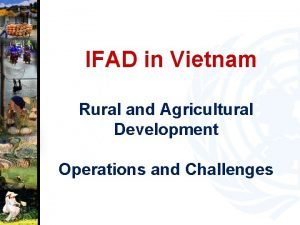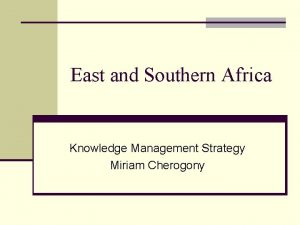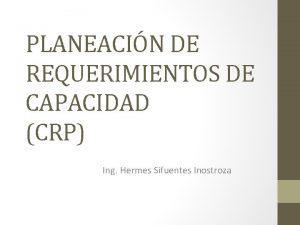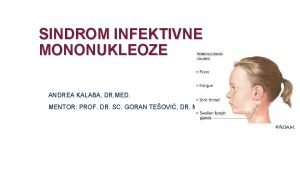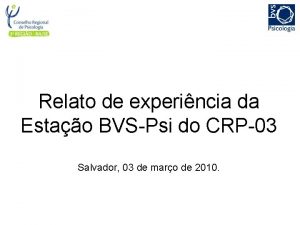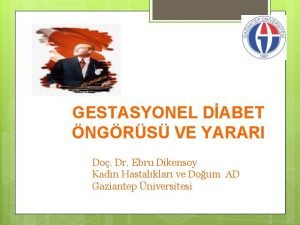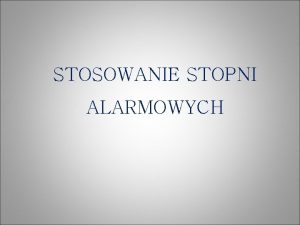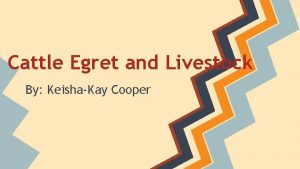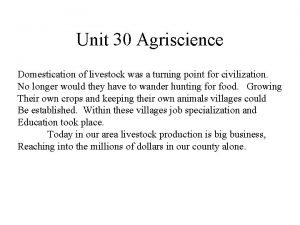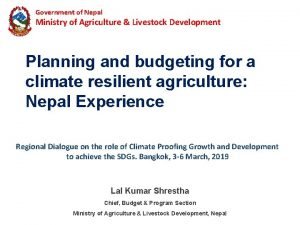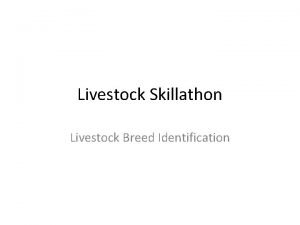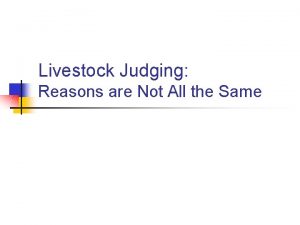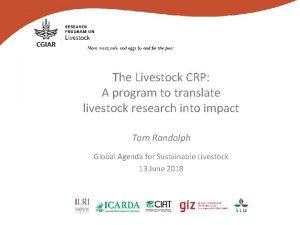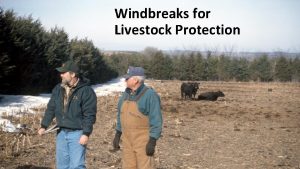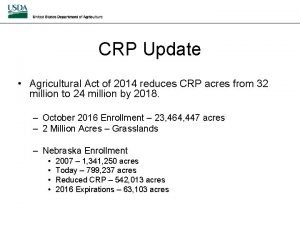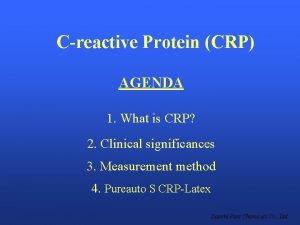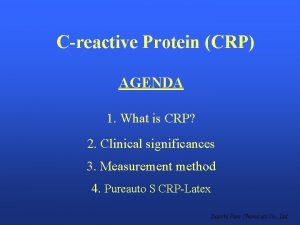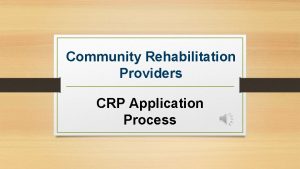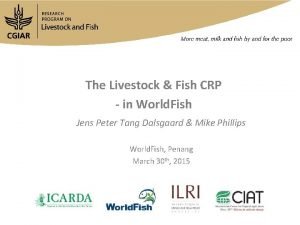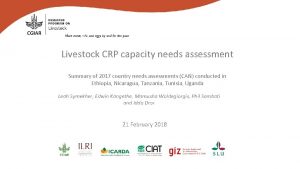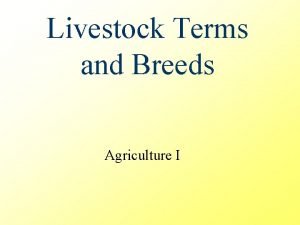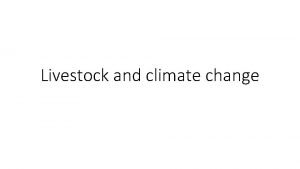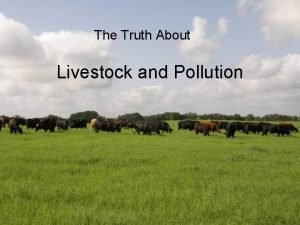CRP Livestock and IFAD Sma RT Project Small





















- Slides: 21

CRP Livestock and IFAD Sma. RT Project: Small Ruminant meat value chain Transformation in Ethiopia Barbara Rischkowsky, ICARDA-ILRI-NARES Sma. RT team Sma. RT Ethiopia workshop and field day on Small Ruminant Community Based Breeding Program (CBBP) Hosaena, Ethiopia, 27– 28 March 2018

Objective and vision of Sma. RT Objective: to improve the performance of sheep and goat meat value chains in Ethiopia and in doing so to improve livelihoods, incomes and assets, particularly of women, through increased productivity, reduced risk and improved market access along the value chain. Vision: By 2023, people in Ethiopia benefit from equitable, sustainable and efficient sheep and goat value chains: their animals are more productive, livestock markets work for producers, consumers and business, there are more, more affordable and healthier small ruminant products, and the livelihoods and capacities of people involved in the whole chain are improved. ”

Consultation and strong Partnerships

SR meat VCT in Ethiopia: framework 1. Consultative site selection process (June-Oct 2012) 2. Complimentary reviews and assessments (July 2012 -Dec 2014) 3. Rapid Value Chain Analysis (VCA) and Rapid Integrated Food Safety assessments at seven sites (Nov 2012 -May 2013) 4. Multi-stakeholder meetings for prioritization and planning of sitespecific interventions and research (March/April 2013) 5. Development of research and development partnerships for implementing prioritized interventions 6. Testing/Implementation/Evaluation of prioritized best-bet interventions (July 2013 -Dec 2016) and complimentary Cap Dev 7. Theory of Change and impact pathways for Ethiopian VC and MEL (2014 -2016) 8. Testing of integrated packages of proven best-bet technologies/interventions (2016 -2019) 9. Development of business models

Prioritized interventions areas § Need based capacity building of extension agents and producers on SR management (input supply and production) § Small Ruminant Health (input supply and production): § Diagnostic and epidemiological studies for key diseases, assessment of economics, capacity building of producers § Delivery services: delivery of quality vaccines, and drugs, organizing delivery of sustainable services § Feeding and Breeding (input supply and production) § Site specific interventions based on available feed resources (adapted forages or shrubs, efficient utilization of crop residues, improved fattening) § Organization/Institutional Interventions related to marketing: § Providing market actors, in particular producers, with up-to-date market price information § Strengthening/Establishing producer marketing cooperatives § Create market linkages between producers and other actors including awareness of market demands § Processing § Capacity building on transport, slaughtering, safe preparation and handling of ASF

Integrated herd health approach to reduce impact of respiratory diseases • Training of male and female farmers and development agents on small ruminant respiratory disease transmission, control measures and husbandry. • Establish effective vaccination and preventive treatment practice for major respiratory diseases and improve the vaccine handling, administration, and adjust timing/schedule. • Village level animal health data recording of morbidity and mortality data due to the disease allows quantification of the impact of the strategic prevention and control. • Systematic follow-up of cases through post mortem analysis and appropriate sample collection for laboratory analysis aiming at future vaccine development • Effectiveness of control programmes for respiratory disease based on scientific judgement of the household/village animal health data

Community-based control of gastro-intestinal tract parasites • Program of training of trainers on causes, clinical signs, treatment, control and adequate prevention methods, including animal management practice targeting extension agents, drug store owners and community animal health workers • To introduce the concept of community-based anthelmintic treatment practices • To demonstrate to farmers how to identify the presence of parasite infection which allows them to monitor their herds • Time table for strategic anthelmintic treatments twice a year, at the beginning of the rainy seasons for nematodes and trematodes. • To monitor impact in selected households, data on animal performance such as body condition, FAMACHA score, body weight, and fecal egg are collected. For all relevant diseases • Disseminate information and establish a locally adopted comprehensive ‘Seasonal Herd Health Calendar’

Feed and feeding systems 1. Characterization of existing feed resources and feeding systems in Ethiopia Assessments across four regions of Ethiopia using two tools: 1. FEAST – to assess of feed resources 2. Techfit – identification and characterization of feed technologies Sensitization of food-feed varieties 2. Introduction of improved sheep fattening methods to smallholders farmers. o Conducted in 2 phases (2015 and 2016) o A total of 600 farmers participated in each phase, with a total of 1200 rams o 4 breed types, Menz, Doyogena, Bonga and Horro o Improved techniques included 3 -month fattening, use of feeding troughs, water troughs, balanced rations Development of a ration balancing tools for sheep § For researchers & extension § For farmers 3. Adoption survey o Identify the influence of attitude, subjective norm, and perceived behavioral control on the intention of farmers to use improved sheep fattening methods 450 farmers across the regions interviewed. Policy brief: Contribution to Government Livestock Policy

Improved sheep fattening techniques Economic viability of supplemented rams vs. control rams Breed Location Fattening profit (ETB) Bonga Boka Control 1130(253)b Supplement 2839(309)a Bonga Buta 1339(154)b 2764(309)a Bonga Shuta 864(438)b 2547(253)a Doyogena Ancha 1818(154)b 1530(121)a Horro Leku 286(150)b 1382(113)a Menz Mehalmeda 1084(219)a 1109(126)a Menz Molale 1409(117)a 1173(78)a Ration balancing tools for sheep

Selection for feed traits in food crops Live weight Changes in Ethiopian Arsi-Bale Sheep fed exclusively on faba bean straws Additional screening of haulms from genotypes should be undertaken in live animals studies before final selection of dual, food-feed varieties.

Pregnancy Diagnosis Service Provision: Ultrasound-based tool to manage sheep and goats reproduction Benefits - Early detection of non pregnant females - Culling of sterile animals - Screening for the number of fetuses - Calculation of the age of fetuses - Timely planning of conditions of birth and rational use of feed resources Mobile ultrasound pregnancy unit in the Badia Jordan The goat obstetric and genecology clinic in Kordofan Sudan

Smart marketing – framework of the study What we tested: Information and collective action increase market participation and market returns of men and women farmers. Market Information: trait preferences, revealed and expected prices, quantity demanded, quantity supplied, availability of and access to market services, and key social [e. g. , extraordinary social occasions] and environmental [e. g. , profound shifts in the weather] phenomena. Informed and Improved market organized Informed and unorganized Uninformed and unorganized understanding More systematic buying and selling Lower costs of buying and selling Improved market trust and linkage Increased interest in marketing Transformation of the SR production system Increased returns to marketing Improved income for male and female farmers Improved wellbeing of men, women, and children

Benefits from Smart Marketing observed so far • Farmers are acting together in the markets and hence improving their bargaining power. • Farmers are sharing the information they are receiving with other farmers with high level of confidence and determination. • They are developing a sense of empowerment due to the information received and the trainings they have attended. • Farmers have reported that their marketing behavior has changed such that they are postponing their buying and selling decisions. • Farmers reported to be more comfortable in going to the market. They are not worried about the hustle they used to experience in the markets due to brokers and traders collision.

Recommendations • The demand for market information is very high. The supply of it is however very limited or nonexistent. • Carefully designed market information system will empower farmers who are often price takers. • Yet, access to efficient telecommunication services cannot easily be taken for granted. • Collective action – when voluntary and focused – helps farmers reduce transaction cost and increase bargaining power. • Farmers have shown a lot of interest in acting collectively and yet managing the group dynamics was not easy. • Provision of market information and collective action certainly improve farmers’ market participation and performance. • Generation/management of the market data and establishing/maintaining a dynamic group action in rural areas require quite a lot of resources and institutional commitments.

Livestock market facilities (sheds for now) The key argument Lack of market infrastructure significantly undermines the market margins farmers generate and elevates the prices they pay for agricultural products when involved as buyers.

Benefits of market facilities observed so far • Very few or no farmers used to bring their sheep and goats to these markets in the rainy season simply because of limited access [due to seasonal rivers] and no sheds in the markets to protect themselves and their animals from the rain. • After the construction of the sheds, it was observed that farmers – in areas where rivers were not cutting the roads to markets -were able to bring in some animals to the markets in the rainy season. • Traders are also staying longer in the markets possibly due to the sheds as the animals are no more exposed to heat and rain while in the markets.

Recommendations • Market sheds/facilities increase market participation and satisfaction (in terms of price per head of animal) of farmers. • Market sheds/facilities are built on plots of land owned by the government and this leads to limited or no sense of ownership. • Farmers could be subjected to taxing due to the sheds. • The establishment costs are very high [financial + nonfinancial terms]. • Scaling market facilities is possible and needs to be done but requires a long-term strategy at macro level on how to develop livestock/small ruminant markets – taking the social and economic functions of markets [including the market plots] in rural Ethiopia into consideration.

Low cost dairy processing technologies Using a thermometer in processing • Prevents contamination by replacing temperature control with fingers • Better control of processing steps Pasteurization • Simple process in which milk is heated to 73°C for 15 seconds where pathogenic bacteria are killed Dairy cultures • Using dairy culture is a simple way to produce a stable product with desired characteristics: o provides the required viscosity and proper texture o develops the desired flavor o helps to prevent pathogenic bacteria

Low cost dairy processing technologies Milk fat separators to improve butter production • Milk fat separation increases the efficiency of butter processing • Milk fat separators offer a solution to handle bigger quantities of milk. • Use of milk fat separator o o reduces labor needed for butter churning increases butter yield improves butter quality allows processing high value products from skimmed milk to increase returns. • Interventions were tested in Abergelle and Yabello targeting goat, cattle and camel keepers • Interventions are very simple to understand to apply • Interventions were well received and appreciated by communities

Low cost dairy processing technologies Smokers • Smoking of milk utensils is a traditional practice to develop the product’s desired organoleptic characteristics. • Smoking also assures quality and safety of milk and dairy products. • Traditional smoking often leaves residues, may contaminate food, and can release toxins. • The easy-to-use beekeeper smoker produces high quality and safe products and satisfies consumers’ taste: • Clean smoke free of contaminants, ash and charcoal • Production of dense smoke even under windy condition • Health safe smoking of plastic milk containers

CGIAR Research Program on Livestock livestock. cgiar. org The program thanks all donors and organizations which globally support its work through their contributions to the CGIAR system The CGIAR Research Program on Livestock aims to increase the productivity of livestock agri-food systems in sustainable ways, making meat, milk and eggs more available and affordable across the developing world. This presentation is licensed for use under the Creative Commons Attribution 4. 0 International Licence.
 Ifad vietnam
Ifad vietnam Ifad knowledge management strategy
Ifad knowledge management strategy Mrp crp
Mrp crp Declaração psicologica
Declaração psicologica Planeación de requerimientos de capacidad (crp ejemplos)
Planeación de requerimientos de capacidad (crp ejemplos) Crp 329
Crp 329 Crp kod mononukleoze
Crp kod mononukleoze Bvspsi
Bvspsi Dabet
Dabet Stopnie alarmowe crp
Stopnie alarmowe crp Crp cerdanyola
Crp cerdanyola Erin brady worsham obituary
Erin brady worsham obituary Esr crp
Esr crp Crp eixample
Crp eixample Cattle egrets and livestock
Cattle egrets and livestock Agriscience unit 30 self evaluation answers
Agriscience unit 30 self evaluation answers Ministry of agriculture and livestock development nepal
Ministry of agriculture and livestock development nepal Livestock breed identification
Livestock breed identification Livestock judging transition terms
Livestock judging transition terms Livestock judging powerpoints
Livestock judging powerpoints Livestock risk management brokers near me
Livestock risk management brokers near me Animal kingdom taxonomy chart
Animal kingdom taxonomy chart
